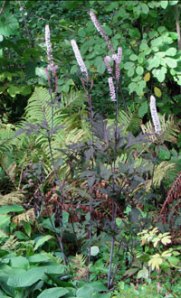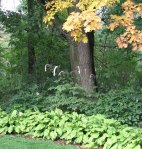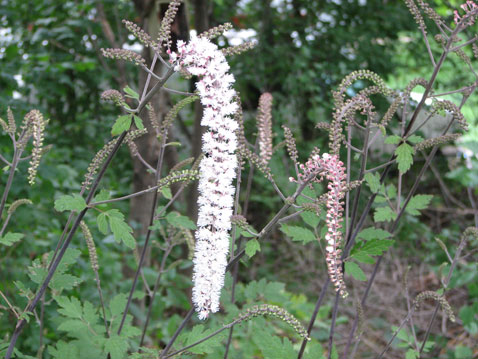By any other name, Actaea is still very sweet
Looking for a large, stunning plant that provides fragrant blooms in the late summer and fall? An Actaea may be what you are seeking.
Actaea, formerly Cimicifuga, is a very large perennial—a couple of my mature plants are about four feet high and seven feet in diameter, with seven foot tall racemes. The species and cultivars make for an excellent large specimens or back-of-the-border plants. Their foliage is outstanding throughout the season.
The large leaves of mature plants offer more than beauty: They allow little, if any, light to reach the ground below them, effectively keeping weeds and other plants from sprouting. So that its own seed has the opportunity to sprout and grow, in winter the tall racemes of the Actaea fall outward around the plant depositing the seeds well out of the shadow of the mother plant.
There are many species of Actaea, with most blooming between mid-summer and mid-autumn, and some blooming later. Actaea bloom for weeks, having bottlebrush-shaped flowers that stand erect or drooping above the plant. Their very sweet fragrance travels lightly on the breeze. I love the smell, however, I recommend planting them away from the house, or at least bedroom windows, as the bouquet of some varieties may smell medicinal to some people, hence the common name bugbane.
Some species of Actaea, like A. racemosa, were used by native peoples medicinally, and is still used by some herbalists. Like many plants and pharmaceuticals, it has toxic properties and should be sited out of the reach of children. Using A. racemosa when taken regularly as an herbal medicine has been linked to liver failure and susceptibility to hepatitis.
In the garden, Actaea have many fine attributes. The finest is they aren’t fussy. I have found them to be a pest-resistant and vigorous plant needing little attention, if properly sited. They can handle light shade or mostly sunny locations, growing taller in shade and shorter in the sun. The darker cultivars require more sun. They like a fairly heavy, dependably moist soil, neutral-to-acidic, with some leave mold, in other words, the type of soil found in woodlands, like the Oak Savanna woodlands here in the Twin Cities area. They native to the Eastern Broadleaf Forest, and are found in zones 3-7, from Ontario to Georgia, west to Arkansas, up and through Minnesota’s Arrowhead and across to Ontario.
I have my Actaea just inside the drip lines of oak trees getting some direct morning sun, but otherwise they spend most of the day in moderate to heavy shade. I have wood mulch around the plants that front them to the edge of the lawn, but under the Actaea I have the leaves I’ve raked in from the lawn in the fall.
I planted my first Actaea in 1993. It was an A. racemosa; common names include Black Cohosh and Black Snakeroot. The plant creates a very dense canopy of shiny, dark, forest green leaves about three feet high, with racemes holding erect, bright white flowers in mid-July to two or three feet above.
In 2000, I purchased an A. racemosa atropurpurea (Black Snakeroot or Branching Bugbane). Unlike the species, it has greater height—a good foot taller, and a very late bloom of mostly drooping panicles filled with snow white flowers. The branching racemes and stems are dark maroon color. Also unlike the A. racemosa, the leaves of this variety are narrower, coarsely toothed, matte, and of a medium green color. It also has a nicer fragrance than A. racemosa.
In 2002, I divided the A. racemosa and planted it on either side of the A. racemosa atropurpurea. The three plants were planted behind a portion of an arc of hosta Honeybells in the northwest corner of my backyard beneath a Red Oak. Click the thumbnail next to last paragraph in this article to see this bed. Pictured are four of the five Actaea now there. A young A. racemosa atropurpurea is on the far left of the photo with A. racemosas alternating in the row with the blooming atropurpureas.
The Tale of Black Beauty
 I purchased a Hillside Black Beauty, a cultivar of A. simplex, in 2002. It is grown for its purple leaves, turning more burgundy and bronze (depending on the light) in autumn, when it begins sporting erect panicles of milk white flowers emerging from burgundy buds. I decided to plant it next to some August Moon hosta on the south side of the backyard.
I purchased a Hillside Black Beauty, a cultivar of A. simplex, in 2002. It is grown for its purple leaves, turning more burgundy and bronze (depending on the light) in autumn, when it begins sporting erect panicles of milk white flowers emerging from burgundy buds. I decided to plant it next to some August Moon hosta on the south side of the backyard.
It typically takes three or four years for an Actaea to start blooming, but their foliage compensates in the meantime. However, after three summers, the Black Beauty was barely showing signs of growth. So, in the fall of 2004, I moved it to the northern end of the line of the other Actaea, as they were doing quite well.
In 2006, I discovered a young A. atropurpurea growing within inches of the base of the Black Beauty, so I moved the little plant to the south end of the line behind a specimen bed of hostas. This gave me a line of five Actaea forming a weak S-shaped curve about 35 feet long, reflecting a truer S-shaped line created by the edge of the lawn in that corner of the yard.
Showing better growth, but still not blooming, in the spring of 2009, I moved the Hillside Black Beauty to an even brighter spot, filling its hole with another young A. atropurpurea that had sprouted up between two Honeybells. The new spot seems to be working out well, as I have gotten nice growth this year. I have it planted next a Gold Heart Bleeding Heart. The dark purple leaves of the Black Beauty contrast very dramatically with the light yellow leaves and scarlet flowers of this Bleeding Heart. (Look for a picture of this pair in 2011.)
 Actaea are very lovely plants. If you have room and the minimal conditions required, it makes a great addition the woodland garden. Their foliage provides value all season, but in the fall when colors are beginning to change; to catch a bit of its fragrance as its tall blooms gracefully sway in the breeze is a delight.
Actaea are very lovely plants. If you have room and the minimal conditions required, it makes a great addition the woodland garden. Their foliage provides value all season, but in the fall when colors are beginning to change; to catch a bit of its fragrance as its tall blooms gracefully sway in the breeze is a delight.
Actaea behind hosta Honeybells, click for larger image.

